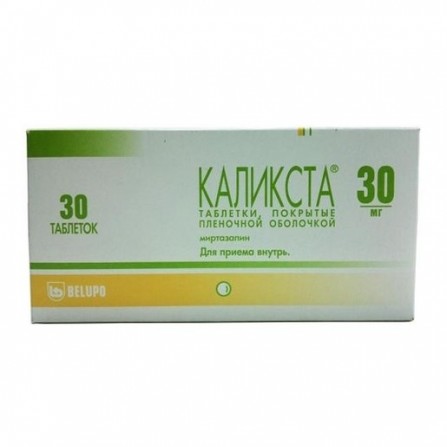Calixta pills 30 mg 30 pcs
Condition: New product
1000 Items
Rating:
Be the first to write a review!

More info
Active ingredients
Mirtazapine
Release form
Pills
Composition
Mirtazapin 30 mg; Excipients: lactose monohydrate - 88.8 mg, corn starch - 56 mg, hyprolosis - 30 mg, microcrystalline cellulose - 30 mg, pregelatinized starch - 30 mg, talc - 2.8 mg, magnesium stearate - 1.4 mg, silicon dioxide - 1 mg.; The composition of the shell: hypromellose-5 CPS - 4.8 mg, macrogol 6000 - 0.4 mg, titanium dioxide - 0.5 mg, iron dye yellow oxide (E172) - 0.15 mg, iron dye red oxide (E172) - 0.05 mg, talc - 0.1 mg.
Pharmacological effect
Antidepressant tetracyclic structure. Enhances central adrenergic and serotonergic transmission. Blocks serotonin 5-HT2- and 5-HT3-receptors, in connection with this increased serotonergic transmission is realized only through serotonin 5-HT1-receptors. Both spatial enantiomers are involved in the manifestation of antidepressant activity: the S (+) - enantiomer blocks the 2-adrenoreceptors and the serotonin 5-HT2 receptors. Moderately blocks histamine H1 receptors, has a sedative effect.; A little effect on 1-adrenergic receptors and cholinergic receptors; in therapeutic doses it does not have a significant effect on the cardiovascular system. In the clinical setting, anxiolytic and hypnotic effects are also manifested, therefore, mirtazapine is most effective in anxiety depressions of different genesis. Due to the moderate sedative effect in the treatment process does not actualize suicidal thoughts.
Pharmacokinetics
Mirtazapin after oral administration is rapidly absorbed from the gastrointestinal tract. Bioavailability is 50%. Cmax in plasma is reached after 2 hours; Css in plasma is set after 3-4 days of continuous administration. Plasma protein binding is 85%. Actively metabolized in the liver by demethylation and oxidation, followed by conjugation. Dimethyl-mirtazapine is also pharmacologically active as the original substance. Mirtazapin is excreted by the kidneys and through the intestines. T1 / 2 makes 20-40 hours; At a renal and liver failure reduction of clearance of a mirtazapin is possible.
Indications
Depressive states (including anhedonia, psychomotor retardation, insomnia, early awakening, weight loss, loss of interest in life, suicidal thoughts and mood lability).
Contraindications
Renal and hepatic failure, pregnancy, lactation, hypersensitivity to mirtazapine.
Use during pregnancy and lactation
Contraindicated for use during pregnancy and lactation.
Dosage and administration
When ingestion, the effective dose for adults is 15-45 mg / day, mostly 1 time / day before bedtime. The dose is gradually increased to 30-45 mg / day. The antidepressant effect develops gradually, usually after 2-3 weeks from the start of treatment, but reception should be continued for another 4-6 months. If within 6-8 weeks of treatment there is no therapeutic effect, treatment should be stopped.; Mirtazapin is discontinued gradually.
Side effects
On the part of the central nervous system and peripheral nervous system: drowsiness, confusion, emotional lability, change of mentality, agitation, anxiety, apathy, hallucinations, depersonalization, hostility, mania, seizures, dizziness, vertigo, hypersensitivity, convulsions, tremor, myoclonus, hyperkinesia, hypokinesia .; From the side of hematopoietic organs: oppression of hematopoiesis - granulocytopenia, agranulocytosis, neutropenia, eosinophilia, aplastic anemia, thrombocytopenia.; From the side of metabolism: a slight increase in appa titus and weight gain; in rare cases - edema. On the part of the cardiovascular system: rarely - orthostatic hypotension; On the part of the digestive system: nausea, vomiting, constipation, increased appetite, weight gain, dry mouth, thirst, abdominal pain; in isolated cases - increased transaminase activity of the liver. On the part of the reproductive system: reduced potency, dysmenorrhea.; Other: skin rash, urticaria, flu-like syndrome, asphyxiation, edematous syndrome, myalgia, back pain dysuria.
Overdose
Experience with an overdose of Calixsta alone indicates that the symptoms are usually mild. Reported CNS depression, accompanied by disorientation and prolonged sedation combined with tachycardia and a weak increase or decrease in blood pressure. However, there is a possibility of more severe results (including death) at doses much higher than the therapeutic dose, especially when overdosing with several drugs taken at the same time .; In case of an overdose, symptomatic therapy should be carried out to support the vital functions of the body. Activated charcoal or flush the stomach should be injected.
Interaction with other drugs
With the simultaneous use of mirtazapine enhances the sedative effect of benzodiazepine derivatives.; The case of the development of a hypertensive crisis while using with clonidine is described.; With the simultaneous use of levodopa, the case of the development of severe psychosis is described; with sertraline - a case of hypomania. With simultaneous use with ethanol, it is possible to increase the inhibitory effect on the central nervous system of ethanol and ethanol-containing drugs.
special instructions
It is used with caution in patients with epilepsy and organic brain damage, with impaired liver and / or kidney function, acute cardiovascular diseases, arterial hypotension, and urinary disorders due to benign prostatic hyperplasia, with angle-closure glaucoma, and diabetes mellitus .; In patients with schizophrenia, mirtazapine may cause increased delirium, hallucinations. When treating the depressive phase of a manic-depressive psychosis, this condition can turn into a manic phase. Sudden discontinuation of mirtazapine after long-term treatment can cause nausea, headache, and a feeling of well-being. body temperature, sore throat, stomatitis treatment should be discontinued and a clinical blood test should be done.; If jaundice appears, mirtazine should be stopped.; It should not be used simultaneously with an inhibitor mi MAO and for 2 weeks after their cancellation.; Development of drug dependence, withdrawal syndrome is possible.; Patients should refrain from alcohol during treatment.; Mirtazapin is not used in children due to the lack of data on the effectiveness and safety of its use in pediatric practice.; Influence on ability to drive motor transport and control mechanisms; Use with caution in patients whose activity is associated with the need for high concentration of attention and speed of psychomotor reactions d.





